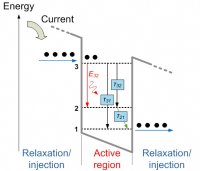7.1 Sources
 Quantum cascade lasers (QCLs) are IR sources based on inter-subband transitions that can operate in a wide range of wavelengths (from 3.5 to 150 μm). Since their invention in 1994, there has been tremendous progress towards the implementation of powerful tunable or single mode lasers which are capable of either continuous wave or pulsed operation at room temperature (RT).
Quantum cascade lasers (QCLs) are IR sources based on inter-subband transitions that can operate in a wide range of wavelengths (from 3.5 to 150 μm). Since their invention in 1994, there has been tremendous progress towards the implementation of powerful tunable or single mode lasers which are capable of either continuous wave or pulsed operation at room temperature (RT).
The noise and modulation properties of QCLs are being discovered every day leading to many important contributions in the field, especially the last years. Spectroscopy and gas sensing are applications which could be extremely benefited from low noise QCLs, as the dominant noise sources of the sensing system are the intensity noise of the laser and the detectivity of the receiver.
 Our group has investigated the noise properties of QCLs targeting to develop sub-systems with very low intensity noise operation. To this end, optical injection locking (OIL) was theoretically investigated as a mean to reduce the intrinsic intensity noise of QCLs for high performance sensing applications. Furthermore, experiments in collaboration with Technical University of Darmstad (TUD) confirmed the theoretical predictions and injection-locked QCL operation with reduced relative intensity noise up to 20 dB was demonstrated.
Our group has investigated the noise properties of QCLs targeting to develop sub-systems with very low intensity noise operation. To this end, optical injection locking (OIL) was theoretically investigated as a mean to reduce the intrinsic intensity noise of QCLs for high performance sensing applications. Furthermore, experiments in collaboration with Technical University of Darmstad (TUD) confirmed the theoretical predictions and injection-locked QCL operation with reduced relative intensity noise up to 20 dB was demonstrated.
Our current activities on mid-IR QCL sources are related to devices operating with intensity noise levels close to the quantum limit, and devices with high modulation-bandwidth.
Related projects
- CLARITY
Publications
- H. Simos, A. Bogris, D. Syvridis, and W. Elsäßer, “Intensity Noise Properties of Mid-Infrared Injection Locked Quantum Cascade Lasers: I. Modeling”, IEEE Journal of Quantum Electronics, vol. 50, pp., 98-105, Feb. 2014
- H. Simos, A. Bogris and D. Syvridis, “Modulation and Noise Properties of Injection Locked Quantum Cascade Lasers,” in proceedings of the International Conference on Semi-conductor Mid-IR Materials and Optics (SMMO 2013), Warsaw, Poland, February-March 2013.
